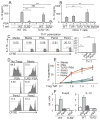The Toll-like receptor 2 pathway establishes colonization by a commensal of the human microbiota
- PMID: 21512004
- PMCID: PMC3164325
- DOI: 10.1126/science.1206095
The Toll-like receptor 2 pathway establishes colonization by a commensal of the human microbiota
Abstract
Mucosal surfaces constantly encounter microbes. Toll-like receptors (TLRs) mediate recognition of microbial patterns to eliminate pathogens. By contrast, we demonstrate that the prominent gut commensal Bacteroides fragilis activates the TLR pathway to establish host-microbial symbiosis. TLR2 on CD4(+) T cells is required for B. fragilis colonization of a unique mucosal niche in mice during homeostasis. A symbiosis factor (PSA, polysaccharide A) of B. fragilis signals through TLR2 directly on Foxp3(+) regulatory T cells to promote immunologic tolerance. B. fragilis lacking PSA is unable to restrain T helper 17 cell responses and is defective in niche-specific mucosal colonization. Therefore, commensal bacteria exploit the TLR pathway to actively suppress immunity. We propose that the immune system can discriminate between pathogens and the microbiota through recognition of symbiotic bacterial molecules in a process that engenders commensal colonization.
Figures





Comment in
-
Commensal microbiota determine intestinal iTreg.Am J Transplant. 2012 Aug;12(8):1967. doi: 10.1111/j.1600-6143.2012.04217.x. Am J Transplant. 2012. PMID: 22845904 No abstract available.
References
Publication types
MeSH terms
Substances
Grants and funding
LinkOut - more resources
Full Text Sources
Other Literature Sources
Molecular Biology Databases
Research Materials
Miscellaneous

